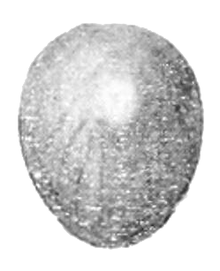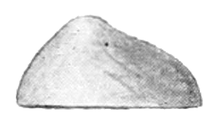- Scenella
-
Scenella
Temporal range: Early Cambrian–Middle Ordovician[1]
Dorsal view of the shell of Scenella tenuistriata 
lateral view of the shell of Scenella tenuistriata Scientific classification Kingdom: Animalia Phylum: Mollusca / Hydrozoa? Superfamily: † Scenelloidea Family: † Scenellidae
S. A. Miller, 1889[2]Genus: Scenella
Billings, 1872Synonyms[3] - Helcionellinae Wenz, 1938
- Hampilinae Kobayashi, 1958
- Securiconidae Missarzhevsky, 1989
Scenella is an extinct genus generally classified as a mollusc; it has been aligned with the gastropods, monoplacophorans, and helcionellids, although a firm association with either class has not been established.[4] An affinity with the hydrozoa (as a flotation device) has been considered,[1] although some authors oppose this hypothesis.[5] A gastropod affinity is defended on the basis of six pairs of internal muscle scars,[6] whilst the serially-repeated nature of these scars suggests to other authors a monoplacophoran affinity.[1] However the specimens showing this scarring have not been convincingly shown to belong to the genus Scenella.[1] A similarity to the Ediacaran Ovatoscutum has also been drawn.[7]
Contents
Description
Scenella is elongated along its anterior-posterior axis, and comprises concentric rings around a conical central peak. Radial and concentric corrugations exist in some species.[7] Some specimens are preserved as organic films, others appear to have been infilled with calcite.[1] They are usually preserved point-upwards, with their long axes consistently oriented; this probably represents their most stable position under their depositional current.[1] Soft parts have never been reported in association with Scenella, suggesting that the preserved fragments separated quickly from the associated tissue prior to burial.[1]
Fossil occurrence
Scenella lived from the Cambrian to the Ordovician. Its remains have been found in Antarctica, Asia, Europe, and North America. Individual fossils are common throughout the Burgess shale, where they often occur in dense aggregations.[1] Where they overlap, specimens deform as by draping.[1] Specimens are sometimes cracked or torn, with margins often damaged by folding or "tattering".[1] 1206 specimens of Scenella are known from the Greater Phyllopod bed, where they comprise 2.29% of the community.[8]
Taxonomy
 Scenella from the Burgess Shale, Middle Cambrian, Walcott Quarry, near Field, British Columbia
Scenella from the Burgess Shale, Middle Cambrian, Walcott Quarry, near Field, British Columbia
Scenella is the only genus in the family Scenellidae. This family has no subfamilies and Scenella is the type genus of the family Scenellidae.
The taxonomy of the Gastropoda by Bouchet & Rocroi, 2005[3] categorizes Scenellidae in the superfamilia Scenelloidea within the Paleozoic molluscs of uncertain systematic position.
Species
Species in the genus Scenella include[9]:
Species Authority Range Scenella affinis Ulrich and Schfield, 1897 Scenella amii (Matthew, 1902) Babcock and Robinson 1988 Burgess Shale (Mid Cambrian, 505 million years ago)[8] Scenella anomala (Billings, 1865) Wagner 2008 Scenella augusta (Billings, 1865) Wagner 2008 Scenella barrandei (Linnarsson, 1879) (Bergerg-Madsen and Peel, 1986)[10] Scenella beloitensis Ulrich and Scofield (1897) Scenella clotho Walcott, 1936 Scenella compressa Ulrich and Scofield (1897) Scenella conica Whiteaves, 1884 Scenella conula (Walcott, 1884) Scenella conicum (Whitfield, 1886) Ulrich and Scofield (1897) Scenella hujingtanensis Yu, 1979 Scenella magnifica Ulrich and Scofield (1897) S.? mira Vasil’yeva, 1994 Scenella montrealensis Billings (1865) Scenella obtusa (Sardeson, 1892) Ulrich and Scofield (1897) Scenella orithyia (Billings, 1865) Ulrich and Scofield (1897) Scenella pretensa Raymond, 1905 Scenella radialis Ulrich and Scofield (1897) Scenella radians Babcock & Robinson Scenella radiata Yu, 1979 Scenella reticulata (Billings, 1872) (type)[11] Image Scenella retusa (Ford, 1873)[12] Scenella unicarinata (Kobayashi, 1934) Wagner 2008 Scenella varians Walcott 1908 Scenella venillia (Billings, 1865) Wagner 2008 Scenella tenuistriata Chapman, 1911 Mid Cambrian[13] References
- ^ a b c d e f g h i j Babcock, L. E.; Robison, R. A. (1988). "Taxonomy and paleobiology of some Middle Cambrian Scenella (Cnidaria) and Hyolithids (Mollusca) from western North America". University of Kansas Paleontological Contributions 121: 1-22. hdl:1808/3638. http://kuscholarworks.ku.edu/dspace/bitstream/1808/3638/1/paleo.paper.121.pdf.}}
- ^ Miller S. A. (after October 1889). North American geology and palaeontology: 389.
- ^ a b Bouchet P. & Rocroi J.-P. (Ed.); Frýda J., Hausdorf B., Ponder W., Valdés Á. & Warén A. 2005. Classification and nomenclator of gastropod families. Malacologia: International Journal of Malacology, 47(1-2). ConchBooks: Hackenheim, Germany. ISBN 3-925919-72-4. ISSN 0076-2997. 397 pp. http://www.vliz.be/Vmdcdata/imis2/ref.php?refid=78278
- ^ ELLIS L. YOCHELSON1 and DOLORES GIL CID2 (1984). "Reevaluation of the systematic position of Scenella". Lethaia 17 (4): 331–340. doi:10.1111/j.1502-3931.1984.tb00679.x. http://www3.interscience.wiley.com/journal/120036307/abstract.
- ^ Landing; Narbonne (1992). "Scenella and "A Chondrophorine (Medusoid Hydrozoan) from the Basal Cambrian (Placentian) of Newfoundland"". Journal of Paleontology (Paleontological Society) 66 (2): 338. doi:10.2307/1305918. JSTOR 1305918.
- ^ Rasetti (1954). "Internal Shell Structures in the Middle Cambrian Gastropod Scenella and the Problematic Genus Stenothecoides". Journal of Paleontology (Paleontological Society) 28 (1): 59–66. doi:10.2307/1300208. JSTOR 1300208.
- ^ a b Benjamin M. Waggoner; Allen G. Collins (March 1995). "A new chondrophorine (Cnidaria, Hydrozoa) from the Cadiz Formation (Middle Cambrian) of California". Paläontologische Zeitschrift (Springer Berlin / Heidelberg) 69 (Numbers 1–2): 7–17. doi:10.1007/BF02985970 (inactive 2010-04-30). ISSN 0031-0220. http://www.springerlink.com/content/m55n7684782l2255/.
- ^ a b Caron, J. -B.; Jackson, D. A. (October 2006). "Taphonomy of the Greater Phyllopod Bed community, Burgess Shale". PALAIOS 21 (5): 451–465. doi:10.2110/palo.2003.P05-070R.
- ^ Scenella. Paleobiology Database, accessed 16 August 2009.
- ^ BERGERG-MADSEN, V.,; J. S. PEEL (1986). "Scenella barrandei (Mollusca) from the Middle Cambrian of Baltoscandia". Norsk geologisk tidsskrift 66 (1): 81–86
- ^ Billings (1872). Can. Nat.. 2nd vi: 479.
- ^ Ford (1873). American Journal of Science. 3 5: 213.
- ^ Chapman F. (1911). "New or Little Known Victorian Fossils in the National Museum". Proceedings of the Royal Society of Victoria, Melbourne 23: 305-324. plate 58-61.; Scenella tenuistriata at 313-314, plate LIX. figure 18 a,b.
External links
- Scenella at the Field Museum's Evolving Planet
Categories:- Burgess Shale fossils
- Scenellidae
- Cambrian animals
- Ordovician animals
- Extinct animals of Antarctica
- Prehistoric animals of Asia
- Prehistoric animals of Europe
- Prehistoric animals of North America
Wikimedia Foundation. 2010.
